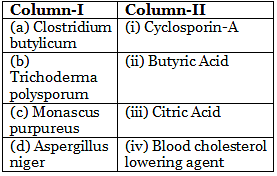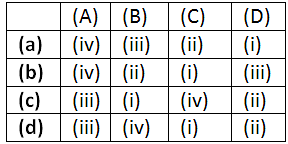NEET Previous Year Questions (2016-2024): Microbes in Human Welfare | Biology Class 12 PDF Download
2024
Q1: Match List I with List II (NEET 2024)
 Choose the correct answer from the options given below:
Choose the correct answer from the options given below:
(a) A-III, B-I, C-II, D-IV
(b) A-II, B-IV, C-III, D-I
(c) A-III, B-I, C-IV, D-II
(d) A-IV, B-I, C-III, D-II
Ans: (c)
2022
Q.1. Identify the microorganism which is responsible for the production of an immunosuppressive molecule cyclosporin A: [NEET 2022 Phase 1]
(a) Clostridium butylicum
(b) Aspergillus niger
(c) Saccharomyces cerevisiae
(d) Trichoderma polysporum
Ans: (d)
Trichoderma species are free-living fungi found in the root ecosystem (rhizosphere). The fungus Trichoderma polysporum is responsible for the production of cyclosporin A. It is used as an immunosuppressive drug and is used by organ transplant patients to avoid graft rejection.
Q2: Given below are two statements: one is labelled as Assertion (A) and the other is labelled as Reason (R). [NEET 2022 Phase 2]
Assertion (A) : Spirulina is a microbe that can be used for reducing environmental pollution.
Reason (R) : Spirulina is a rich source of protein, carbohydrates, fats, minerals and vitamins.
In the light of the above statements, choose the most appropriate answer from the options given below:
(a) (A) is not correct but (R) is correct
(b) Both (A) and (R) are correct and (R) is the correct explanation of (A)
(c) Both (A) and (R) are correct but (R) is not the correct explanation of (A)
(d) (A) is correct but (R) is not correct
Ans: (c)
- Spirulina can be grown easily on materials like waste water from potato processing plants, so it can reduce environmental pollution. It can serve as food rich in protein, minerals, fats, carbohydrates and vitamins.
- Hence, option (c) is correct as both (A) & (R) are correct but (R) is not correct explanation of (A).
2021
Q1: Match List - I with List - II [NEET 2021]
Choose the correct answer from the options given below.
Ans: (c)
Examples of acid producers are Aspergillus niger (a fungus) of citric acid, Acetobacter aceti (a bacterium) of acetic acid; Clostridium butylicum (a bacterium) of butyric acid and Lactobacillus (a bacterium) of lactic acid.
2020
Q1: Which of the following is put into Anaerobic sludge digester for further sewage treatment? [NEET 2020]
(a) Effluents of primary treatment
(b) Activated sludge
(c) Primary sludge
(d) Floating debris
Ans: (b)
Major portion of activated sludge is pumped into large tanks called anaerobic sludge digesters. So, here other kinds of bacteria which grow anaerobically, digest the fungi and bacteria of the sludge.
Q2: Match the following columns and select the correct option. [NEET 2020]


Ans: (d)
Clostridium butylicum (a bacterium) is used for the production of butyric acid. An bioactive molecule, cyclosporin A, that is used as an immunosuppressive agent in organtransplant patients, is produced by the fungus Trichoderma polysporum. Statins produced by the yeast Monascus purpureus have been commercialized as blood-cholesterol lowering agents. It acts by competitively inhibiting the enzyme responsible for synthesis of cholesterol. Aspergillus niger (a fungus) is used for the commercial production of citric acid.
2019
Q1: Select the correct group of biocontrol agents. [NEET 2019]
(a) Nostoc, Azospiiillium, Nucleopolyhedrovirus
(b) Bacillus thuringiensis, Tobacco mosaic virus, Aphids
(c) Trichoderma, Baculovirus, Bacillus thuringiensis
(d) Oscillatoria, Rhizobium, Tiichoderma
Ans: (c)
- Biocontrol refers to the use of biological methods for controlling plant diseases and pests. Bacillus thuriengiensis (Bt), Trichoderma sps and Baculoviruses are used as biocontrol agents.
- Rhizobium, Nostoc, Azospirillum and Oscillatoria are used as biofertilisers, which increases the fertility of soil while Tobacco Mosaic virus is a pathogen that infects wide range of plants and aphids are pest that harms crop plants.
Q2: Match the following organisms with the products they produce. [NEET 2019]
Select the correct option.

Ans: (c)
Lactobacillus is used for production of curd, Saccharomyces cerevisiae is used for making bread, Aspergillus niger is used in citric acid production while Acetobacter aceti is used in acetic acid production.
Q3: What triggers activation of protoxin to active Bt toxin of Bacillus thuringiensis in boll worm? [NEET 2019]
(a) Acidic pH of stomach
(b) Body temperature
(c) Alkaline pH of gut
(d) Moist surface of midgut
Ans: (c)
Protoxin are converted into active toxins in the alkaline pH of gut.
Q4: Thiobacillus is a group of bacteria helpful in carrying out : [NEET 2019]
(a) Nitrification
(b) Denitrification
(c) Nitrogen fixation
(d) Chemoautotrophic fixation
Ans: (b)
Thiobacillus denitrificans cause denitrification. Denitrification is the process of conversion of oxides of nitrogen to free nitrogen by bacteria present in the soil.
Q5: Which of the following can be used as a biocontrol agent in the treatment of plant disease? [NEET 2019]
(a) Lactobacillus
(b) Trichoderma
(c) Chlorella
(d) Anabaena
Ans: (b)
A biological control being developed for use in the treatment of plant disease is the fungus is trichoderma trichoderma species are free living fungi that are very common in the root ecosystems. They are effective biocontrol agents of several plant pathogens.
Q6: Which of the following is a commercial blood cholesterol-lowering agent? [NEET 2019]
(a) Lipases
(b) Cyclosporin A
(c) Statin
(d) Streptokinase
Ans: (c)
- Streptokinase is used as a ‘clot buster’ to remove clots from the blood vessels of patients who have myocardial infarction.
- Lipases are used in detergent formulations. It helps to remove oily stains from the laundry.
- Cyclosporin A is produced by Trichoderma polysporum (fungus) and used as an immunosuppressive agent in organ transplant patients.
- Statins are produced by Monascus purpureus yeast. It is used as blood-cholesterol lowering agents. It inhibits the enzymes responsible for synthesis of cholesterol.
2018
Q1: Conversion of milk to curd improves its nutritional value by increasing the amount of [NEET 2018]
(a) vitamin D
(b) vitamin A
(c) vitamin B12
(d) vitamin E
Ans: (c)

Curd has enriched presence of vitamins specially Vitamin B12, which improves its nutritional value than milk.
2017
Q1: Select the mismatch. [NEET 2017]
(a) Rhodospirillum - Mycorrhiza
(b) Anabaena - Nitrogen fixer
(c) Rhizobium — Alfalfa
(d) Frankia - Alnus
Ans: (a)
Rhodospirillum is facultative anaerobe and free living nitrogen fixer. Mycorrhiza show symbiotic relationship between fungi and roots of higher plants.
Q2: Which of the following in sewage treatment removes suspended solids? [NEET 2017]
(a) Secondary treatment
(b) Primary treatment
(c) Sludge treatment
(d) Tertiary treatment
Ans: (b)
Primary treatment is a physical process which involves two process, i.e. filtration and sedimentation of big solid waste.
Q3: Which of the following is correctly matched for the product produced by them? [NEET 2017]
(a) Methanobacterium: Lactic acid
(b) Penicillium notatum: Acetic acid
(c) Sacchromyces cerevisiae: Ethanol
(d) Acetobacter aceti: Antibiotics
Ans: (c)
Saccharomyces cerevisiae commonly know as Brewer’s yeast, causes fermentation of carbohydrates and produces ethanol.
2016
Q1: Which of the following is wrongly matched in the given table? [NEET 2016 Phase 1]
Ans: (b)
Clostridium butylicum helps in the production of butyric acid. Candida Upolytica and Geotrichum candidmn help in production of lipases that are added in detergents for removing oily stains from laundry.
Q2: Match Column-I with Column-II and select the correct option using the codes given below – [NEET 2016 Phase 2]

(a) (a) - (iii), (b) - (i), (c) - (ii), (d) - (iv)
(b) (a) - (iii), (b) - (iv), (c) - (i), (d) - (ii)
(c) (a) - (iii), (b) - (i), (c) - (iv), (d) - (ii)
(d) (a) - (i), (b) - (iv), (c) - (ii), (d) - (iii)
Ans: (c)
(a) Pistils fused together : This refers to a condition in flowers where multiple pistils are united. The correct term for this is (iii) Syncarpous.
(b) Formation of gametes : This is the process of forming gametes (sex cells) in organisms. The correct term for this is (i) Gametogenesis.
(c) Hyphae of higher Ascomycetes : In higher Ascomycetes (a group of fungi), the hyphae are often dikaryotic, meaning they have two distinct nuclei in each cell. The correct term for this is (iv) Dikaryotic.
(d) Unisexual female flower : This describes a flower that has only female reproductive organs. The correct term for this is (ii) Pistillate.
Based on this analysis, the correct matching is :
(a) - (iii)
(b) - (i)
(c) - (iv)
(d) - (ii)
Therefore, the correct option is :
Option C : (a) - (iii), (b) - (i), (c) - (iv), (d) - (ii)
2015
Q2: Match the following list of microbes and their importance: [NEET 2015]

Ans: (d)
a - (iii), b - (iv), c - (i), d - (ii)
- The source of ethanol for industrial use was from the fermentation of sugars by yeast (Sacharomyces cerevisiae).
Red yeast rice is a substance that's extracted from rice that's been fermented with a type of yeast called Monascus purpureus.
Red yeast rice is a traditional Chinese medicine that has been used to lower cholesterol.
Trichoderma is used as an immunosuppressant prescribed in organ transplants to prevent rejection.
There are three primary types of bacteria that are used to make Swiss cheese: Streptococcus thermophilus; Lactobacillus helveticus; and Propionibacterium shermanii.
It is this Propionibacterium shermanii that is responsible for the holes in Swiss cheese.
2014
Q1: What gases are produced in anaerobic sludge digesters? [NEET 2014 / AIPMT 2014 ]
(a) Methane and CO2 only
(b) Methane, Hydrogen Sulphide and CO2
(c) Methane, Hydrogen Sulphide and O2
(d) Hydrogen Sulphide and CO2
Ans: (b)
Anaerobic digestion is a series of processes in which microorganisms break down biodegradable material in the absence of oxygen, used for industrial or domestic purposes to manage waste and/or to release energy. The process of anaerobic digestion produces a biogas, consisting of methane (it will burn), carbon dioxide (it does not burn) and traces of other contaminant gases.
Q2: An alga which can be employed as food for human being is : [NEET 2014 / AIPMT 2014 ]
(a) Polysiphonia
(b) Chlorella
(c) lothrix
(d) Spirogyra
Ans: (b)
Chlorella is a single celled chlorophycean alga with rich protein content. It is considered as a source of SCP (single cell protein) and also as food source during long space travels.
Q3: Which one of the following fungi contains hallucinogens? [NEET 2014 / AIPMT 2014 ]
(a) Morechella esculenta
(b) Neurospora sp.
(c) Amanita muscaria
(d) Ustilago sp.
Ans: (c)
Several mushrooms such as Amanita muscaria, Psilocybe mexicana and Panaeolus spp. secrete hallucinogenic substances like psilocybin and psilocin. These substances may destroy brain cells and power of perception in human beings.
|
78 videos|276 docs|174 tests
|
FAQs on NEET Previous Year Questions (2016-2024): Microbes in Human Welfare - Biology Class 12
| 1. What are the different ways in which microbes are utilized in human welfare? |  |
| 2. How do microbes contribute to the production of antibiotics? |  |
| 3. What role do microbes play in biodegradation processes? |  |
| 4. How are microbes involved in the production of enzymes for industrial use? |  |
| 5. Can microbes be used in the production of biofuels? |  |

|
Explore Courses for NEET exam
|

|


















